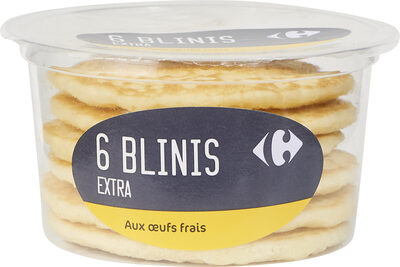6 Blinis extra - Carrefour - 150 g (6 x 25 g)
This product page is not complete. You can help to complete it by editing it and adding more data from the photos we have, or by taking more photos using the app for Android or iPhone/iPad. Thank you!
×
Some of the data for this product has been provided directly by the manufacturer Carrefour.
Barcode: 3560071192464 (EAN / EAN-13)
Common name: 6 Blinis.
Quantity: 150 g (6 x 25 g)
Brands: Carrefour
Categories: Plant-based foods and beverages, Plant-based foods, Snacks, Cereals and potatoes, Salty snacks, Appetizers, Breads, Special breads, fr:Blinis
Labels, certifications, awards: Free range, Free range eggs, Nutriscore
Origin of ingredients: France, Brittany
Traceability code: EMB 22093K - Lamballe (Côtes-d'Armor, France), FR 22.093.041 CE - Lamballe (Côtes-d'Armor, France)
Stores: Carrefour, carrefour.fr
Countries where sold: France
Matching with your preferences
Other information
Preparation: Réchauffer 15 à 20 secondes au grille-pain ou poêler à feu doux quelques minutes. En apéritif ou en entrée, coupés en portions ou présentés en entier, ils se marieront parfaitement avec une crème fraîche ciboulette, du saumon fumé, des rillettes de poisson, ou tout autre tartinable, selon les envies.
Conservation conditions: À conserver jusqu'au / N° de lot : voir sur le devant de l'emballage À conserver au frais entre 0 et 8°C. À consommer dans les 48 heures après ouverture. Conditionné sous atmosphère protectrice
Customer service: Interdis - TSA 91431 - 91343 MASSY Cedex - France
Report a problem
Data sources
Product added on by kiliweb
Last edit of product page on by fpdsurveys.
Product page also edited by chevalstar, driveoff, hungergames, openfoodfacts-contributors, org-carrefour, roboto-app, sebleouf, teolemon, yuka.HYJJLdyuBdI-H8DfzoQ1hiipFsP8KKZZQlAmow, yuka.NOgSLMzUIPQtPvDd9YYu4BqCPujuI8JSA1Jcow, yuka.Zlo0UUNvUUF2L013aWZjYW9oTDcrZkpUeDdTRmJGaVNNZU5KSUE9PQ, yuka.sY2b0xO6T85zoF3NwEKvllBkD-HUjjPnHDDmumON6Y2lAca1XupC_5LhMag.













